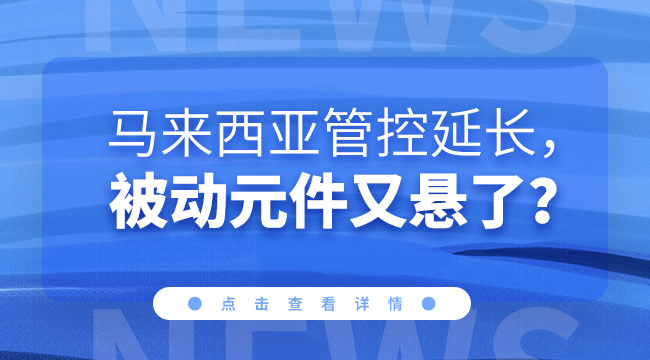Malaysia's control is extended, and the passive component is suspended again?
Date:2021-06-18 15:41:07 Views:4305

Since May, the epidemic situation in Malaysia has been heating up, and the daily peak of new diagnosis has exceeded9000 cases. Under the severe situation, the Malaysian government began to implement the comprehensive operation control for half a month on June 1. After that, the number of new cases per day showed a downward trend.
Malaysia is a major player in the worldOne of the IC industry concentration areas, gathering a large number of chip OEM, back-end packaging and testing and passive component production lines. Compared with chip manufacturing and packaging testing, the automatic production level of passive components is not high and requires more manpower. According to the requirements of the control order, Japanese and Taiwan factories can only operate at a low level of manpower, which will obviously have a great impact on shipments.
In this context, when will Malaysia be able to"Unsealing" has become the focus of attention. However, the current epidemic situation is difficult to turn. The Malaysian government has announced that it will extend the control for another two weeks to June 28. This means that the low capacity operation of passive component manufacturers will be maintained and the market supply will be limited.
The epidemic infiltrated the production line and the original factory suffered
It is reported that as early as MalaysiaDuring the "city closure" in early June, local Taiwan passive component factories wangquan and huaxinke were required to operate with 10% - 20% low manpower. Industry insiders said that it was equivalent to maintaining "no shutdown". Japanese factory jiameigong and Panasonic were informed that they could only maintain 60% manpower operation, and the other American factory AVX was also affected. The shipment of MLCC, chip resistor, solid-state capacitor and aluminum capacitor for vehicles is limited.
In addition to the reduction in production due to epidemic prevention, the epidemic also directly impacted some passive component production lines in Malaysia. Daily plant solar induced electricityOn June 4, it was announced on the official website that the shutdown had been extended to June 14 due to the diagnosis of employees in the plant. Previously, due to routine maintenance, the solar induced power plant in Malaysia has been shut down since May 29. The delay in returning to work due to cases is an unplanned situation. According to the official information, the solar induced power plant in Malaysia has resumed operation.

Source: solar induced electricity official website
It is understood that the solar induced electricityMLCC ranks fourth in terms of shipment volume, accounting for about 13% of the market, and plays an important role in high gross profit fields such as mobile phone high capacity MLCC and vehicle MLCC. Solar induced power prolongs the shutdown time of Malaysian plant, which may deepen the supply gap of high capacity MLCC.
With the extension of control in Malaysia, the low manpower operation of local passive component factories will continue, which will further restrict product shipments. The supply and demand pattern of the passive component market in the second half of the year will be affected.
With the arrival of the electronic peak season, the supply chain will start to pull goods
In the second half of the year,The PC market will usher in the peak season, and the new iPhone will also be available. These are important demand growth points. The supply chain must be ready to pull goods, which will certainly bring more demand for passive components, but whether to promote the price rise depends on the cooperation of other factors.
This year, the shortage of components and the rise in prices continued, but all kinds ofThe shortage of IC and passive components is different, which evolves the problem of "long and short materials". For passive components, although they are also out of stock, there are many mature process ICs that are more in short supply than them, so they are still "long material" on the whole.
Reviewing the market changes since the outbreak of the epidemic last year, the price of passive components did not rise much last year, and the market quickly picked up after the Spring Festival this year. In terms of original factories, Guoju, wangquan and other Taiwan factories, together with several major Japanese and Korean factories, have raised prices, involving all kinds of resistance and capacitance products, reflecting the price rise of the upstream supply chain and the widening gap between supply and demand. In the second quarter, only Guoju announced the price increase, mainly reflecting the increase of upstream costs.
Looking forward to the market in the second half of the year, Malaysia"City closure" runs through the whole June, which may make the industrial chain worry that passive components will become "short materials" and step up the preparation of goods, so as to promote the shortage and price rise to be more radical. However, in contrast, IC materials in some categories may be more scarce, resulting in the limited stocking power of the supply chain for passive components.
But anyway, Malaysia"City closure" must be a major event in the passive component industry this year. The IC market generally rose in the first half of the year. In the second half of the year, with the further emergence of the problem of "long and short materials", there may be differentiation. Whether the price of passive components rises or not also depends on the supply situation of other components. However, if the Malaysian epidemic persists, it will inevitably be detrimental to the supply of passive components. In this case, the shortage will overshadow various factors and become the tone of the market.




 Weixin Service
Weixin Service

 DouYin
DouYin
 KuaiShou
KuaiShou





















